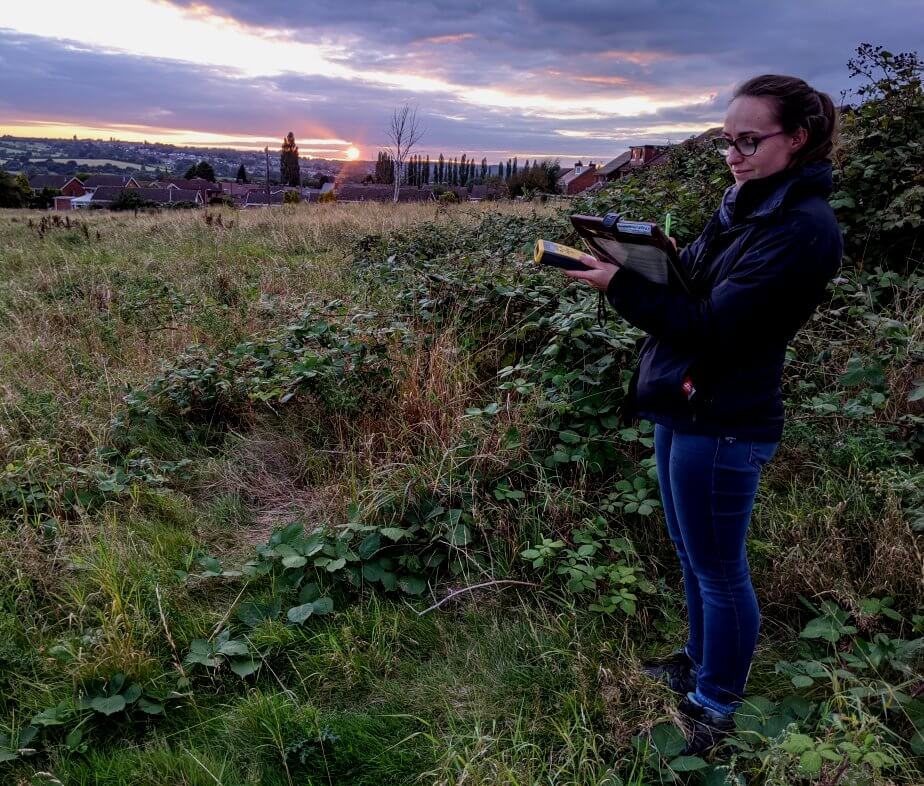

Our ecologists at Morph Ecological Consultants are extremely experienced in undertaking bat surveys as well as designing and implementing mitigation measures when bat roosts may be impacted by development projects. We undertake bat surveys mainly across Nottinghamshire, Derbyshire and Leicestershire, but cover the rest of the UK too. We work with our extended network of ecologists to provide local and specialist input where required.
Please see our ‘Frequently Asked Questions: Bats’ page for more information on bat surveys, licences to allow works that might impact bat roosts, and other information regarding bats and bat surveys.
All bat species are afforded full protection under UK and European legislation, including the Wildlife and Countryside Act 1981 (as amended), and The Conservation of Habitats and Species Regulations 2017 (as amended). Together, this legislation makes it illegal to:
A bat roost is defined in the legislation as “any structure or place which a bat uses for shelter or protection”. Roosts are protected whether or not bats are present at the time.
It is therefore important when carrying out any works that may impact a bats (e.g. tree works, building works etc.) to consult with an ecologist early on in the project to avoid any potential delays.
If a development may impact bats, the first stage typically involves a daytime bat survey, during which licenced ecologists search the buildings or trees for evidence of roosting bats. Evidence of bats includes bat droppings, feeding remains as well as looking for live bats. The daytime bat survey also assesses the site's potential to support roosting bats, which involves identifying features such as cracks in brickwork, holes in soffits or lifted tiles. If the survey is of a building, the survey usually involves both an inspection of the exterior of the building as well as a search for evidence within the building’s interior (if safe to do so).
Should evidence of bats be recorded, or features with bat roosting potential noted (features that cannot be fully inspected during the daytime survey), further bat activity surveys will be required (see below).


Bat activity surveys can only be undertaken during suitable weather conditions within the bat activity season (i.e. May to September inclusive) and involve surveyors monitoring the potential bat roosting features at dusk or dawn with electronic bat detectors (and where appropriate Infra-Red video recording equipment) to determine whether any bats exit or enter buildings (or a structure or trees).
To meet current industry guidelines and planning requirements a minimum of two activity surveys may be necessary, and in some cases (where evidence of bats has been recorded), three surveys may be required.
Where it is necessary to determine the value of a site for foraging bats, a bat transect can be undertaken. This involves surveyors walking a predetermined route around a site at night recording (for later analysis) bat calls. Stopping points, where surveyors record for 5 minutes at a set location, are also sometimes included. Static bat detectors may also be left on site for a period of time to determine the level of bat activity and the species of bats present.
Depending on the results of the bat activity surveys, and if it is determined that the works risk disturbing bats and destroying roosting sites (and the proposed works cannot be redesigned to avoid impact to bats), the works must proceed with a licence from Natural England. One of two licencing routes outlined below may be possible:
Can be used where there will be impacts to no more than three low conservation significant roosts (e.g. low numbers of bats using the building as day, feeding, night and transitional roosts) of no more than three common species bats in low numbers. The licensable works must be carried out within 6 months.
The licence can only be applied for by registered consultants no more than 12 weeks prior to undertaking any licensable works. Natural England will provide a response within 10 working days. A registered consultant would need to be present to oversee the licensable works and there should be pre-erected bat boxes nearby should a bat/s be found during the works.
Can be used where the Bat Mitigation Class Licence criteria cannot be met e.g. a large number of bats, maternity/hibernation roost or the licensable works will take longer than six months.
The licence can be applied for at any time, however Natural England take a minimum of 30 working days (currently response time is delayed to 45 days) to respond to the application. There is a requirement for the licence application to document all necessary work timings, mitigation, compensation and monitoring, to ensure the potential impact to bats is offset. Mitigation could include restricting the works timings to outside of the maternity or hibernation period. Compensation could include the installation of bat roosting features within new buildings, the installation of bat boxes, provision of an alternative roost. There is also usually a requirement for between 1 and 3 annual post-completion monitoring surveys to be carried out following the completion of the construction works. A licenced ecologist would need to be present to oversee the works and there should be a pre-erected bat boxes nearby should a bat/s be found during the works.
Mitigation and compensation measures are completely project specific and can be designed to blend within the proposed development, whilst also providing the appropriate requirements for bats.